The Intel 6th Gen Skylake Review: Core i7-6700K and i5-6600K Tested
by Ian Cutress on August 5, 2015 8:00 AM ESTWhat You Can Buy: Office and Web Benchmarks
For the last segment of graphs, we have the same data as the previous few generational pages but we have also included other processors from our database for non-standard comparisons.
All of our benchmark results can also be found in our benchmark engine, Bench.
Office Performance
Dolphin Benchmark: link
Many emulators are often bound by single thread CPU performance, and general reports tended to suggest that Haswell provided a significant boost to emulator performance. This benchmark runs a Wii program that raytraces a complex 3D scene inside the Dolphin Wii emulator. Performance on this benchmark is a good proxy of the speed of Dolphin CPU emulation, which is an intensive single core task using most aspects of a CPU. Results are given in minutes, where the Wii itself scores 17.53 minutes.
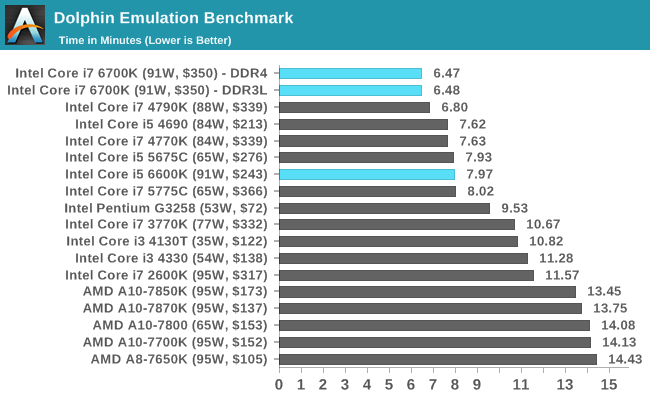
WinRAR 5.0.1: link
Our WinRAR test from 2013 is updated to the latest version of WinRAR at the start of 2014. We compress a set of 2867 files across 320 folders totaling 1.52 GB in size – 95% of these files are small typical website files, and the rest (90% of the size) are small 30 second 720p videos.
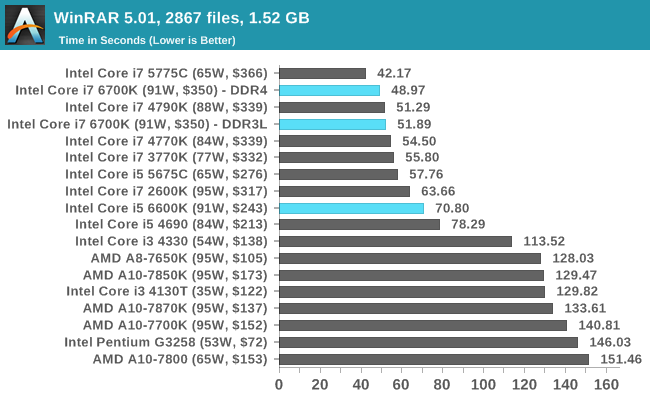
3D Particle Movement
3DPM is a self-penned benchmark, taking basic 3D movement algorithms used in Brownian Motion simulations and testing them for speed. High floating point performance, MHz and IPC wins in the single thread version, whereas the multithread version has to handle the threads and loves more cores.
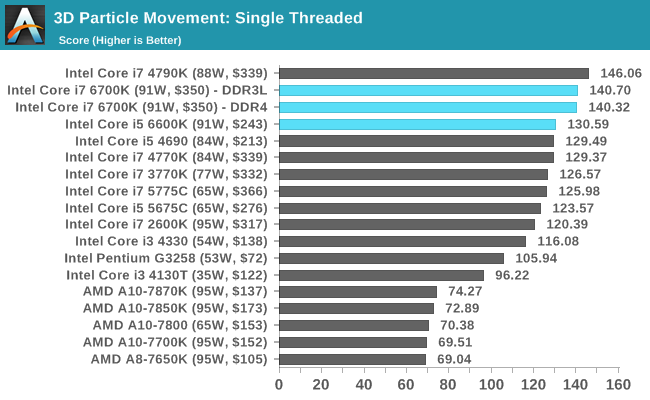
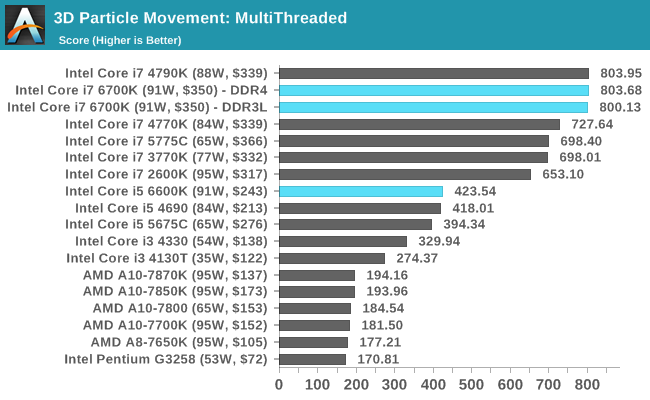
FastStone Image Viewer 4.9
FastStone is the program I use to perform quick or bulk actions on images, such as resizing, adjusting for color and cropping. In our test we take a series of 170 images in various sizes and formats and convert them all into 640x480 .gif files, maintaining the aspect ratio. FastStone does not use multithreading for this test, and results are given in seconds.
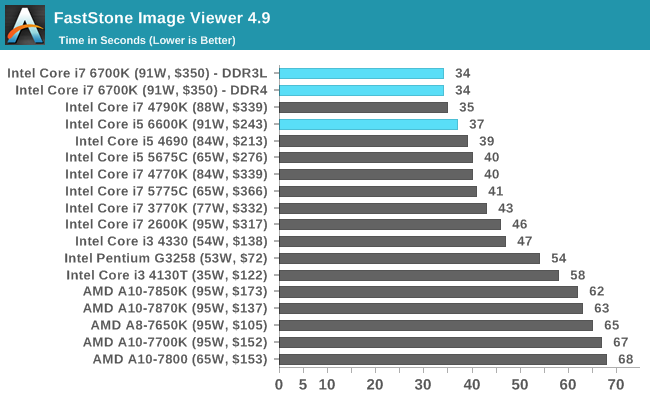
Web Benchmarks
On the lower end processors, general usability is a big factor of experience, especially as we move into the HTML5 era of web browsing. For our web benchmarks, we take four well known tests with Chrome 35 as a consistent browser.
Sunspider 1.0.2
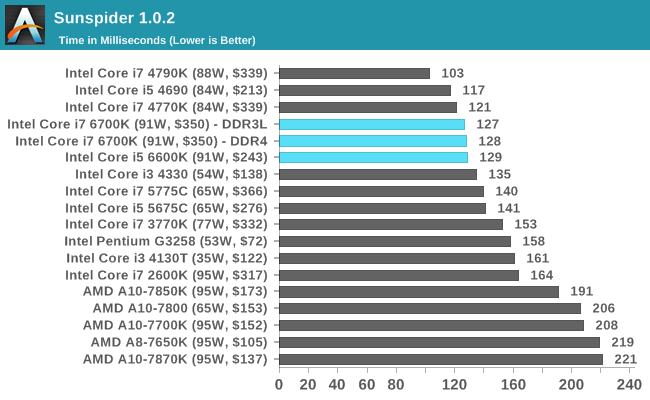
Mozilla Kraken 1.1
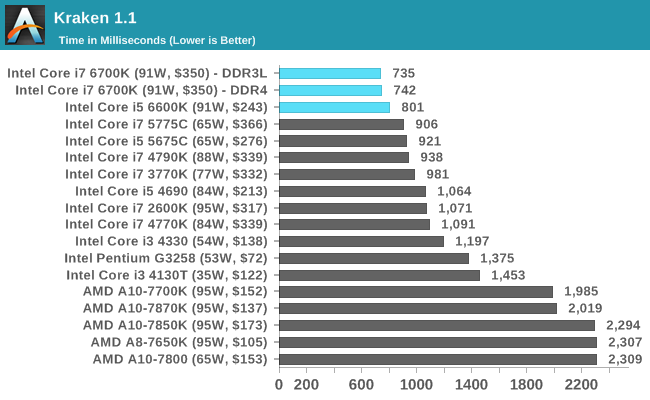
WebXPRT
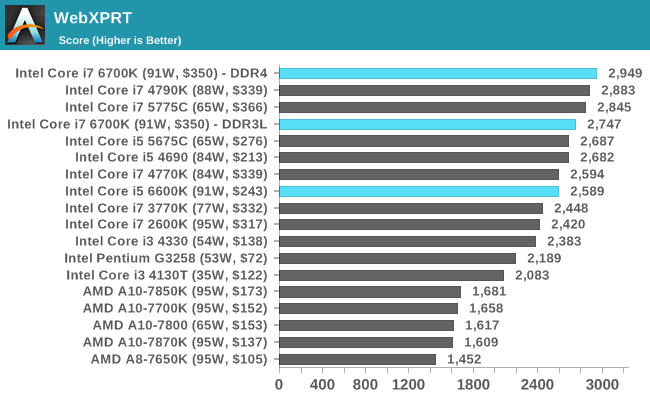
Google Octane v2
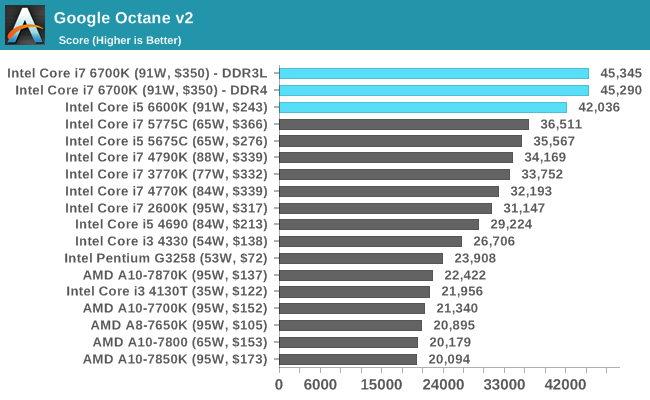










477 Comments
View All Comments
SkOrPn - Tuesday, December 13, 2016 - link
Well if you were paying attention to AMD news today, maybe you partially got your answer finally. Jim Keller yet again to the rescue. Ryzen up and take note... AMD is back...CaedenV - Wednesday, August 5, 2015 - link
Agreed, seems like the only way to get a real performance boost is to up the core count rather than waiting for dramatically more powerful single-core parts to hit the market.kmmatney - Wednesday, August 5, 2015 - link
If you have an overclocked SandyBridge, it seems like a lot of money to spend (new motherboard and memory) for a 30% gain in speed. I personally like to upgrade my GPU and CPU when I can get close the double the performance of the previous hardware. It's a nice improvement here, but nothing earth=shattering - especially considering you need a new motherboard and memory.Midwayman - Wednesday, August 5, 2015 - link
And right as dx12 is hitting as well. That sandy bridge may live a couple more generations if dx12 lives up to the hype.freaqiedude - Wednesday, August 5, 2015 - link
agreed I really don't see the point of spending money for a 30% speedbump in general, (as its not that much) when the benefit in games is barely a few percent, and my other workloads are fast enough as is.If Intel would release a mainstream hexa/octa core I would be all over that, as the things I do that are heavy are all SIMD and thus fully multithreaded, but I can't justify a new pc for 25% extra performance in some area's. with CPU performance becoming less and less relevant for games that atleast is no reason for me to upgrade...
Xenonite - Thursday, August 6, 2015 - link
"If Intel would release a mainstream hexa/octa core I would be all over that, as the things I do that are heavy are all SIMD and thus fully multithreaded, but I can't justify a new pc for 25% extra performance in some area's."SIMD actually has absolutely nothing to do with multithreading. SIMD refers to instruction-level parallellism, and all that has to be done to make use of it, for a well-coded app, is to recompile with the appropriate compiler flag. If the apps you are interested in have indeed been SIMD optimised, then the new AVX and AVX2 instructions have the potential to DOUBLE your CPU performance. Even if your application has been carefully designed with multi-threading in mind (which very few developers can, let alone are willing to, do) the move from a quad core to a hexa core CPU will yield a best-case performance increase of less than 50%, which is less than half what AVX and AVX2 brings to the table (with AVX-512 having the potential to again provide double the performance of AVX/AVX2).
Unfortunately it seems that almost all developers simply refuse to support the new AVX instructions, with most apps being compiled for >10 year old SSE or SSE2 processors.
If someone actually tried, these new processors (actually Haswell and Broadwell too) could easily provide double the performance of Sandy Bridge on integer workloads. When compared to the 900-series Nehalem-based CPUs, the increase would be even greater and applicable to all workloads (integer and floating point).
boeush - Thursday, August 6, 2015 - link
Right, and wrong. SIMD are vector based calculations. Most code and algorithms do not involve vector math (whether FP or integer). So compiling with or without appropriate switches will not make much of a difference for the vast majority of programs. That's not to say that certain specialized scenarios can't benefit - but even then you still run into a SIMD version of Amdahl's Law, with speedup being strictly limited to the fraction of the code (and overall CPU time spent) that is vectorizable in the first place. Ironically, some of the best vectorizable scenarios are also embarrassingly parallel and suitable to offloading on the GPU (e.g. via OpenCL, or via 3D graphics APIs and programmable shaders) - so with that option now widely available, technologically mature, and performant well beyond any CPU's capability, the practical utility of SSE/AVX is diminished even further. Then there is the fact that a compiler is not really intelligent enough to automatically rewrite your code for you to take good advantage of AVX; you'd actually have to code/build against hand-optimized AVX-centric libraries in the first place. And lastly, AVX 512 is available only on Xeons (Knights Landing Phi and Skylake) so no developer targeting the consumer base can take advantage of AVX 512.Gonemad - Wednesday, August 5, 2015 - link
I'm running an i7 920 and was asking myself the same thing, since I'm getting near 60-ish FPS on GTA 5 with everything on at 1080p (more like 1920 x 1200), running with a R9 280. It seems the CPU would be holding the GFX card back, but not on GTA 5.Warcraft - who could have guessed - is getting abysmal 30 FPS just standing still in the Garrison. However, system resources shows GFX card is being pushed, while the CPU barely needs to move.
I was thinking perhaps the multicore incompatibility on Warcraft would be an issue, but then again the evidence I have shows otherwise. On the other hand, GTA 5, that was created in the multicore era, runs smoothly.
Either I have an aberrant system, or some i7 920 era benchmarks could help me understand what exactly do I need to upgrade. Even specific Warcraft behaviour on benchmarks could help me, but I couldn't find any good decisive benchmarks on this Blizzard title... not recently.
Samus - Wednesday, August 5, 2015 - link
The problem now with nehalem and the first gen i7 in general isn't the CPU, but the x58 chipset and its outdated PCI express bus and quickpath creating a bottleneck. The triple channel memory controller went mostly unsaturated because of the other chipset bottlenecks which is why it was dropped and (mostly) never reintroduced outside of enthusiast x99 quad channel interface.For certain applications the i7 920 is, amazingly, still competitive today, but gaming is not one of them. An SLI GTX 570 configuration saturates the bus, I found out first hand that is about the most you can get out of the platform.
D. Lister - Thursday, August 6, 2015 - link
Well said. The i7 9xx series had a good run, but now, as an enthusiast/gamer in '15, you wouldn't want to go any lower than Sandy Bridge.